|
Way back, when I was really starting to explore the sheer breadth of comedy talent that flourished in Hollywood during the silent era, the films of Charlie Chaplin were starting to fall out of favour and get unfavourably compared to the work of Buster Keaton. A few years later opinion had done a reactive about-face and Chaplin was being celebrated once again as a comedy great and those earlier naysayers were being loudly mocked. All except Edmund Blackadder, of course. I've never been a fan of this trend for picking one artist over another like it's a competition in which there can only be one winner, but I will admit that in my formative years, I always preferred Keaton to Chaplin. Only some years later, when I was better able to appreciate Chaplin's extraordinary talent for knockabout comedy, did I realise that my preference was driven in part by the respective screen personas of the two comedians, preferring as I did Keaton's deadpan stoicism to Chaplin's loveable tramp. See how I resisted the urge to put the word 'loveable' in inverted commas there? But I also realised that my fondness for Keaton was based on only a small and possibly unrepresentative number of his films, most of which were nigh-on impossible to see back in pre-digital days. Even today, after years of searching and careful restoration work, pristine prints of many of his films seem likely to remain the stuff of cineaste dreams. That we can see them at all is a minor miracle, considering that the very concept of film preservation on a meaningful scale is a relatively recent one.
Back in 2006, Eureka gave us all the chance to right this unfortunate wrong when they released Buster Keaton – The Complete Short Films 1917-1923 as a 4-disc DVD box set. For some reason I never got around to covering it for the site – perhaps the very idea of watching and writing about 32 films and a spattering of extra features proved too intimidating or logistically impossible at the time. When I did get around to watching the films I did so in a largely random order, fitting them in whenever I had a half-hour or so to spare. In the process I probably even missed a couple, shoddy behaviour for a professed Keaton fan. With the arrival of the review discs for this Blu-ray upgrade, I thus made a pledge that I would cover this release no matter what. I owed it to myself and to Eureka's Masters of Cinema label, having failed to cover a number of their recent releases for a range of iffy reasons, from issues with dialogue clarity on Queen of Earth (which may well be mine alone) to being so immersed in our gargantuan review of the BFI's Alan Clarke box set that I could not find time to cover Kurosawa Kiyoshi's Journey to the Shore.
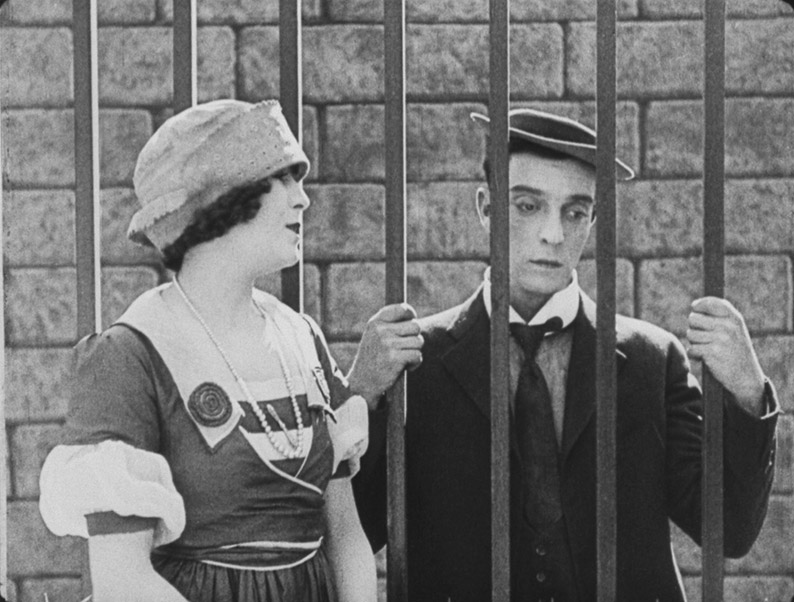
This also gave me the chance to watch the films in the order in which they were made and presented in this set, and in the process appreciate how Keaton evolved as a comic performer and eventually as a writer and director of considerable note. It still proved to be a sizeable job. The films here vary from 21 to 28 minutes in length, and watching all 32 and the extra features swallowed up all of my free time for something like ten days on the trot. But it was free time I revelled in. Some films are more successful than others as complete works of silent comedy (personal taste alert), but there are absolutely no duds and there are many, many moments of real comic genius liberally peppered throughout this set, not all of which are down to Keaton, as it happens. The release also includes a 184-page book that is so packed with facts and opinion that it will doubtless render anything that I might write as second-hand – whatever I say, it's probably been said in more detail and with more authority there. If I sound uncertain it's because when reviewing any disc at Outsider we tend to save all of extra features until after we've finished writing the main review, lest they somehow shape or even contradict our own opinions. That they sometimes say the self same thing as we have written is something we have long ago learned to live with here.
For those with only a passing knowledge of how Keaton's career developed, it may come as a surprise to learn that the first 13 titles in this collection are not Buster Keaton films at all but the work of Roscoe "Fatty" Arbuckle. A major comedy talent in his day and an inventive director of his own films to boot, he is credited with giving Keaton his first film role, as well as mentoring Charlie Chaplin and discovering Bob Hope. It's thus a tragedy that he is too often chiefly remembered for the accusations made against him for the rape and manslaughter of actress Virginia Rappe, for which he was tried three times and ultimately acquitted, all of which came too late to save Arbuckle's critically damaged career, and even today tends to overshadow the work of one of the silent era's genuine comedy greats. And if you're looking for evidence of Arbuckle's considerable talent both as a performer and director then you'll find it in these films. It's certainly clear that Arbuckle was a major influence on Keaton's own brand of physical comedy, which is already on show in the first film in this set (and Keaton's debut), the 1917 The Butcher Boy, where his talents are put to such effective use that this small supporting role plays almost like a guest appearance from an established comic talent. But Arbuckle's own skills rightly dominate here, notably when he flips a slab of meat over his shoulder and onto a meat hook without a passing glance and then casually tosses a knife in the air, where it spins around twice before impaling itself tidily in the chopping board below. And in case the double-take this will likely trigger prompts you to search for signs of visual trickery, Arbuckle repeats the same knife trick twice more throughout the course of the film in a way that leaves no doubt that it was done for real. And he makes it look effortless. One of Arbuckle's neatest tricks, one Keaton successfully adapted and developed, was to make the extraordinary look everyday, executing eye-popping moves in a casual manner whilst wearing an expression of dazed innocence.
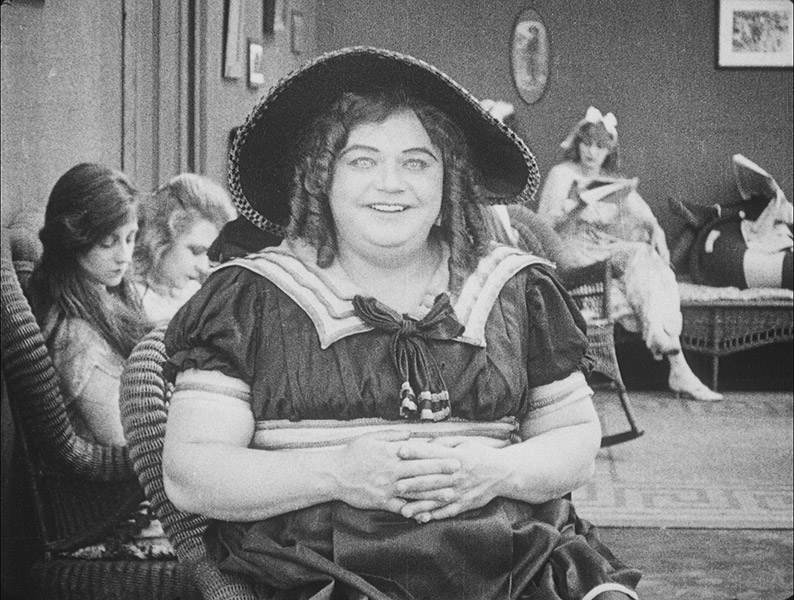
Arbuckle's rotund girth and cherubic features also enabled him to effortlessly switch gender when the story demanded – dressed as a woman he was far more convincingly feminine in his looks and body language than most of his contemporaries, so much so that when Buster uses a fishing rod to lift of his bonnet and wig in Coney Island, he seems to change gender before your very eyes. He also wasn't going to let the absence of sound get in the way of a word pun or two – the early films here include a surly fellow named Mr. Grouch, an educational academy run by Miss Teachems, a dangerous outlaw named Wild Bill Hiccup, a medical man with the outrageous moniker of Dr. Holepoke, and a pretty young manicurist called Miss Cutie Cuticle. My favourite of these is an advertisement for a medicinal soap that is written in a font so narrow that you almost miss the promotional assurance that you should "Use it every day and you'll live until you die." You'll even see one of Keaton's most famous (and dangerous) stunts – the falling house gag from the 1928 Steamboat Bill Jr. – trial run by Arbuckle on a smaller scale when part of a house wall stage set falls on him in the 1919 Back Stage and leaves him unscathed because he passes through the upstairs window as it descends (Keaton himself also gave this a first try a year later in his own One Week).
Increasingly Keaton grew to be less as one of Arbuckle's troupe of supporting players (which also included a dog that could chase you anywhere, even up and down ladders) than his comedy sidekick, a mentorship that clearly allowed him to shape his own distinctive screen persona. And this was an aspect of Keaton's comedy that was definitely not there from the start – those who know him primarily for his famously deadpan expression, the 'Great Stone Face', may be genuinely startled to see a far more expressive Keaton here – in the 1917 Oh Doctor! you'll see him smiling, laughing and even wailing like a baby as Arbuckle's infantile dimwit of a son.
A number of silent comedy tropes do get carried through from Arbuckle's films to Keaton's own. A favoured structure has a reluctant hero pursuing a seriously cute girl, his progress hampered by the actions of a rival for her affections or another sometimes randomly introduced antagonist, whom he will outwit or defeat by the end to win the girl's hand in rapidly decided and executed marriage. Guns are rarely shown to be dangerous or get aimed with anything approaching a steady hand, and while a bullet in the chest will almost definitely kill you, most victims of gunplay get shot in the behind, which stings like hell but can be recovered from in seconds and appears to leave no lasting damage. More surprising is that five of the Keaton directed films in this collection conclude with the revelation that all or part of what has gone before was just a dream, which in time would become perhaps the most reviled movie cliché of all, though critic Joseph McBride makes a case for this repeated use of the dream-in-story twist by Keaton as a tool to let his fondness for surreal gags and black humour run loose. And for the first seven minutes of The Playhouse, Keaton still puts this hoariest of twists to extraordinary use, with a dream of a theatrical production in which he not only plays every role – women and children included – but also openly acknowledges that he is doing so with the comment from an audience member (also played by Keaton, as is his wife) that "this fellow Keaton seems to be the whole show" and a shot of a theatre programme in which every role in the production is credited to him. The sequence itself is a technical showstopper, with some seamless multiple exposure shots placing multiple Keatons on screen at the same time, peaking at nine with a wide shot of a minstrel band. It also foreshadows a celebrated sequence in Being John Malkovich when the titular actor takes a trip inside his own head and finds himself in a world where everyone looks like him and all the dialogue consists solely of his surname.
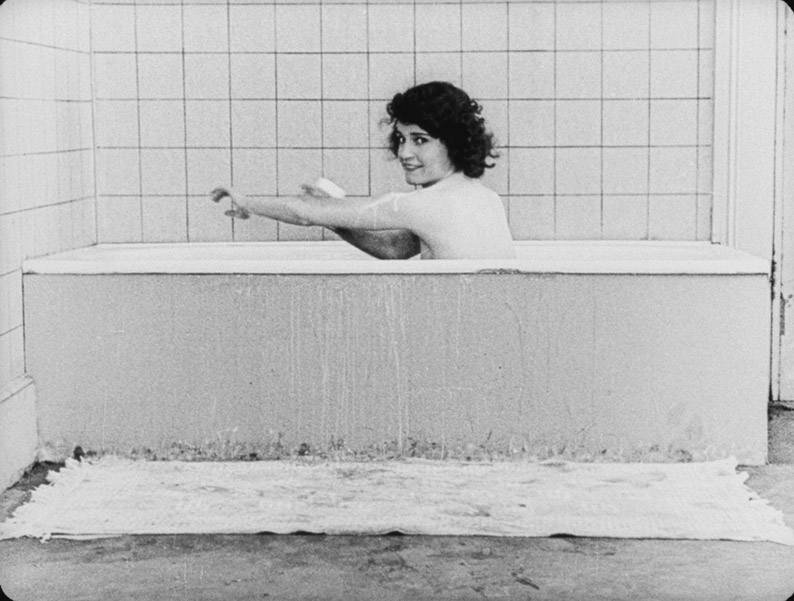
This is not the only example of fourth wall busting on display here. In Coney Island, Arbuckle directly converses with the audience whilst undressing, while at one point in The Boat, Sybil Seely as Keaton's wife looks directly into the camera with the same expression of weary disbelief that Oliver Hardy would later make his own. When the same actress drops the soap while bathing in One Week and is in danger of exposing herself to the camera should she reach out to retrieve it, a large hand appears and covers the lens to protect her modesty, an action she acknowledges with a knowing smile. One of my favourites is a blink-and-you'll miss it moment in The Haunted House, where Keaton runs rapidly towards and past the camera, and just before leaving frame looks directly into the lens in what almost plays like a personal reminder that he's doing all this for our entertainment. An altogether more sophisticated example is a banana skin that seems to be lying in wait for Keaton in The 'High Sign' but which he sidesteps and knowingly acknowledges by flashing the secret sign of an in-film criminal organisation known as the Blinking Buzzards to the audience as he passes. But far and away the most extraordinary examples of this pre-postmodernism occur throughout Moonshine, where just about everyone involved appears to know that they are in a film and that the action and story in which they are participating is all an artificial construct. Initially this can be a little disconcerting – in the opening scene, when a moonshiner demonstrates a switch to open a secret door, the caption informs us that it was "the director's idea," which initially had me wondering if I'd accidentally selected a factual text track – but once you twig what's going on it adds a layer of anarchic fun and inventive unpredictability to the proceedings.
Inevitably, perhaps, some elements have not dated as comfortably as others. That black characters sometimes get a raw deal is not that surprising, but while the black caddy at an otherwise all-white golfing club is a sign of the times (and the character is not played in a demeaning manner), there will be few who will not be sucking air through their teeth at the scene in Out West where the white saloon patrons amuse themselves by forcing a terrified African-American to dance by shooting at his feet until he is rescued by a kindly white young Salvation Army girl. Effeminate dandies come across as being as camp as a row of pink chiffon tents in a pansy field, but while in the Arbuckle directed Out West Native Americans are portrayed as cannibalistic bad guys, in the 1922 The Paleface (written and directed by Keaton and regular collaborator Eddie Cline), they are shown to be essentially peaceful people driven to conflict by ruthless white oil barons looking to steal their land. Keaton's character – a daffily self-absorbed lepidopterist – even ends up joining their tribe and marrying a squaw – not bad considering that Native Americans would continue to be portrayed as lethal and largely faceless antagonists in American westerns for a good few decades to come.
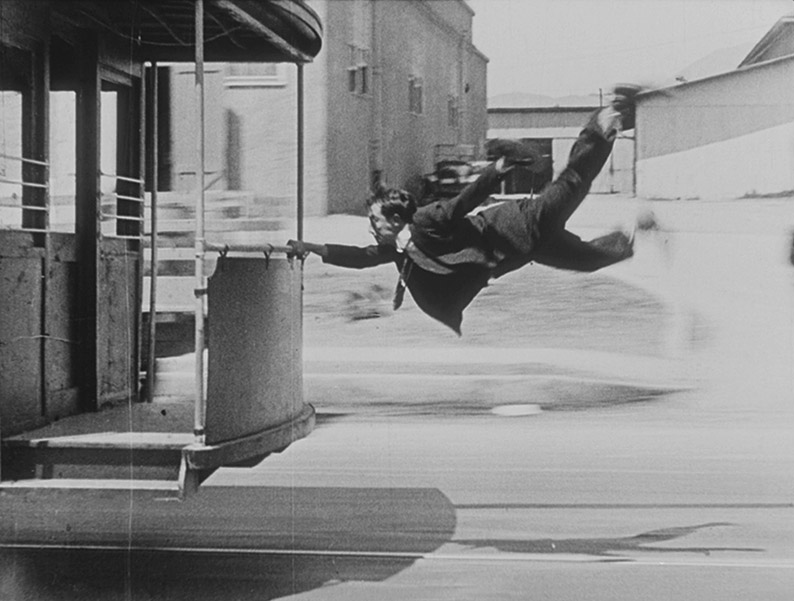
But the appeal and considerable value of these films lies not in their reflection of the societal attitudes of their day but the dizzying invention and sometimes jaw-dropping physicality of their comedy. I have to admit to not being all that surprised when I first heard Jackie Chan quote Keaton as a key inspiration for his own unique brand of physically demanding martial arts comedy, especially considering what both were prepared to put their bodies through for a potentially jaw-dropping visual gag – Keaton famously broke his neck during the shooting of his 1924 feature Sherlock Jr. (an injury he remained unaware of for some years), while Chan suffered a skull fracture and bleeding to the brain as a result of a misfired stunt during the filming of Armour of God. Frankly, it's a miracle Keaton didn't break every bone in his body over the course of his film career, so spectacular were his choreographed stunts and falls. In his early films for Arbuckle in particular he seems almost to be testing the limits of his body's endurance – his first appearance in His Wedding Night has him cycling with a box containing a wedding dress balanced on his head and tumbling spectacularly off the bike and onto his head like he's auditioning for a lead role in Jackass. A particular specialty of his in these early days was a spinning fall to the ground that simultaneously feels both painfully clumsy and balletically graceful – imagine a dancer trying to execute a high roundhouse kick and being lifted off of the ground and spun rapidly in the air by the momentum before landing sharply on the ground on their back, buttocks or head. My personal favourites are the tumbles that switch purpose midway and in the process are transformed from violent to graceful, as in the moment in Oh Doctor! where Arbuckle pushes Keaton backwards over a table and he rolls into a chair and opens a book in a fluid and unflustered movement as if this is how he always sits down to relax. It's the fact that these sometimes breathtaking stunts were all done for real that helps these films retain their freshness even today, a commitment to the craft and willingness to take risks that really stand out at a time when any stunt you care to name can be convincingly faked, and when we have to be assured up front that stunts were done for real to feel any sense of genuine danger for the performers.
As was common in silent comedy shorts of the period, the films all move at a breathless pace, which ensures that if one gag doesn't tickle your fancy then you'll not have to wait long for one that probably will. And neither Arbuckle nor Keaton were content just to string a series of slapstick incidents, fights and pratfalls together, instead enriching their comedy and enlivening the storylines with sequences and gags whose ingenuity, complexity and ability to surprise are rich rewards in themselves. There really are too many in this set to mention, but here are a few randomly selected favourites plucked from memory: the forceful restaurant tumble that carries Keaton out of a dining room and into the kitchen and lands him at the very spot where Arbuckle is chopping meat, where he comes within a hair's breadth of losing his head; the big dipper ride in Coney Island that hits the water with such force it throws its occupants out of the car; the elevator in The Bell Boy that is operated by having a horse haul it up on a rope from outside the building; the pillow fight in Good Night Nurse that quickly explodes into a blizzard of feathers; Arbuckle's emulation of an exotic dancer in The Cook (actually he's emulating Keaton's own amusing emulation of the dancer) that turns into a performance of Salome, with costume and props made up from kitchen implements and food; the fake snow being scattered on Arbuckle during a theatrical performance in Backstage that suddenly intensifies to the point where it obliterates everything on screen; Arbuckle measuring the diameter of his would-be fiancé's ring finger by poking it in a round of cheese and finding a pickle that fits perfectly in the hole; the almost ludicrously complex trickery involving a rope, a dog and a bell that Keaton rigs up in The 'High Sign' to convince a shooting gallery owner that he is crack shot; the hilariously Heath Robinson-like rigs for convenient dining and easy clearing up in The Scarecrow; the man seemingly walking on water in a swimming pool in Hard Luck who is revealed to be actually standing on stilts; the superb opening gag of The Boat that plays like the titular craft is riding rough seas only to reveal it's being shaken playfully by Keaton's young son; the brilliant moment in Daydreams where a wanted Keaton goes to board an empty trolley car only to have scores of hidden cops suddenly appear from inside; the extraordinary kickback from a harpoon gun in The Love Nest that blows the gun apart and propels its operator over the side of the boat. And this is just a small sampling from a list that would go on for pages were I to reproduce it in its entirety.
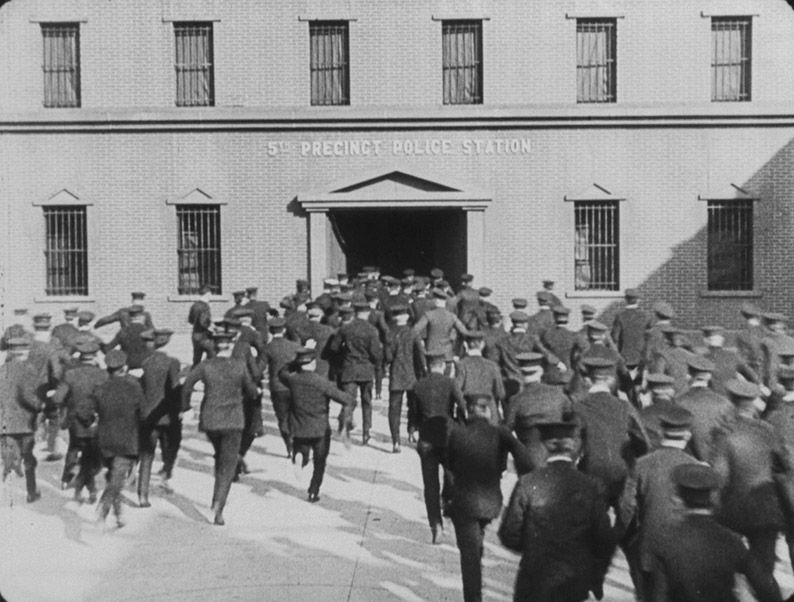
What also strikes you is the sheer scale of some of the gags, particularly in the later, Keaton (co-) directed films, and the time, energy and patience that must have been required to set up and execute a sequence that would only occupy a few short seconds of screen time. This is especially evident in the appropriately titled Cops, where Keaton is at one point being chased by what looks like about two-hundred policemen, or the distorted house constructed and transported in One Week, which is spun round in circles and later destroyed in one of the best and most explosive misdirection gags in silent comedy. It's also hard not to marvel at the conception and construction work that went into The Electric House, where a good half of the gags are based around devices that had to be designed and built and actually made to work specifically for the film. And not all of them are fanciful – the concept of a model train that delivers food to your table and collects the empty plates is one still being used at a famous sushi restaurant in Osaka.
As mentioned above, the comedy intermittently stretches beyond the purely visual and on to the intertitles and even the (captioned) dialogue, as with the hangman who measures Keaton up for execution and tells him "Your neck seems suitable," or the caption accompanying the apprehension of Keaton by the police after a complicated search that assures us: "After searching everywhere else, the police found him where he was." The one that made me laugh the loudest had Keaton pursuing a girl and finally kneeling at her feet and asking, "Now who could oppose our marriage?" only to have her respond, "No one, except my husband, over there." Just occasionally a gag appears to be tied to its time in a manner that left me having to guess its inspiration, as with the man with a broken arm who is asked what happened to him and replies, "I bought a Ford." Come again? And despite the popular trait of the hero getting the girl, Keaton was not averse to the odd bit of gallows humour or the occasional downbeat ending. One film ends with him being kicked out of a second storey window by a would-be father-in-law for failing to live up to the expectations he set for his daughter's hand in marriage, while in another he responds to unexpected romantic rejection by handing himself over to an army of furious cops to be murdered by them – in case there is any doubt, the words 'The End' are shown carved in a tombstone with Keaton's signature boater perched jauntily on the top.
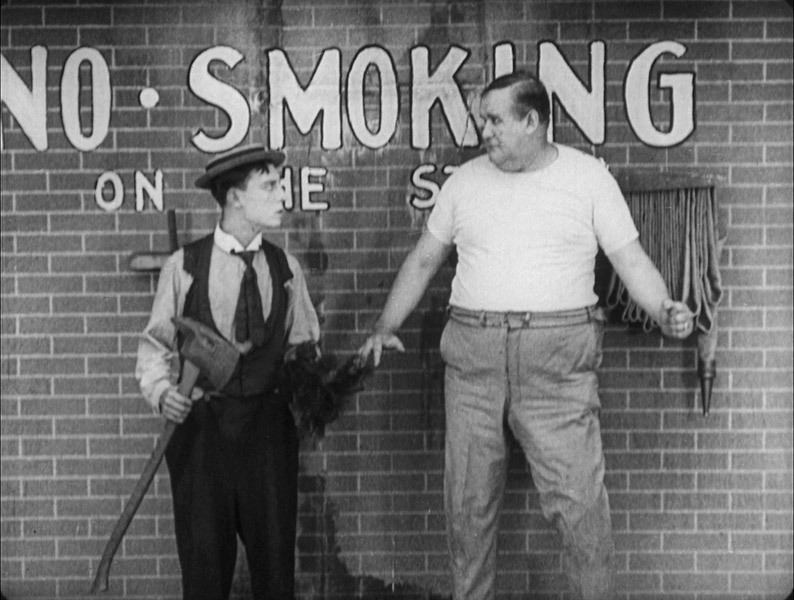
Ah, where to quit? Even though I've prattled on at my usual length, I've only skimmed the surface about what's good and great about the films in this collection, and a good many of them haven't even had a mention here. My original intention was to also cover each of the films individually, but just three films in I realised that this task would probably take me another couple of weeks to complete and I'm already several days late on this review. And yet all of the films deserve the sort of coverage that those of us scribbling and watching in our free time – note that there is over 15 hours of viewing here including the extra features – just cannot afford to give it if a review of any sort is ever going to get posted. All you really need to know is that Buster Keaton – The Complete Short Films 1917-1923 is a brilliant box set literally brimming with inventive and richly entertaining comedy and a glorious showcase for the talents involved. Fans of Keaton, Arbuckle and silent comedy in general need to get their hands on and cherish this release.
But wait, what's that you say? You already have the 2006 Eureka Masters of Cinema DVD box set of the same, so what could this new Blu-ray release possibly offer to prompt you to upgrade? Oh, where to start…
Okay, we all know that if a title that was previously released on DVD is then re-released on Blu-ray and drawn from the same, hopefully HD master, then there will at least be a visible improvement in picture detail, particularly if you have a wall-sized TV. But that's not what we're looking at here, no sir. In the booklet that accompanied the earlier DVD set, disc producer Nick Wrigley talks about the joys and frustrations of putting that set together, and concluded with this hope:
"In this era of 4K high definition capture and restoration and, sadly, film decomposition, I hope this box set goes some way to encourage a full-scale international attempt at definitively restoring both picture and original intertitles for these wondrous short films – in high definition – so that new restored 35mm film prints may be created for future generations."
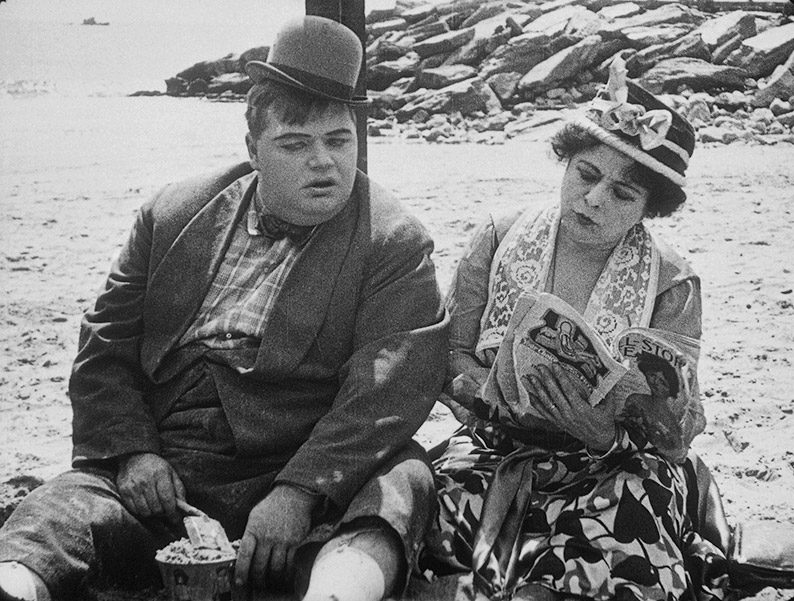
Well his hopes have, to a large part, been answered here. Allow me to quote again, this time Serge Bromberg from Lobster Films from the booklet that accompanies this new Blu-ray release:
"This new restoration of the Buster Keaton and surviving Arbuckle-Keaton shorts has been an enormous project. Even after collecting source copies for twenty years, we hesitated before plunging in. But it has been such a great pleasure – even a joy – to revisit these jewels frame by frame from old negatives, master positives and prints to achieve Keaton's reincarnation!
"Not a frame, not a sound in the Blu-ray set in your hands comes from previous editions. New orchestral scores, international film research, fresh film scans in 2K or 4K... the year we spent in intense work with our team of ten colleagues, building this edition shot by shot, flew by at the speed of light."
This hasn't just resulted in the hoped-for improvements in picture quality – more on which below – but has unearthed some previously unavailable and even thought lost material. And this goes beyond the restoration of previously missing frames and shots. On the DVD set, the extraordinary, self-referential Moonshine ran for just 6 minutes and 45 seconds and was prefaced by the following text:
"Originally released in May 1918, Moonshine is not known to survive in complete 35mm form. What follows are the only existing 35mm fragments from Cineteca Nazionale in Rome."
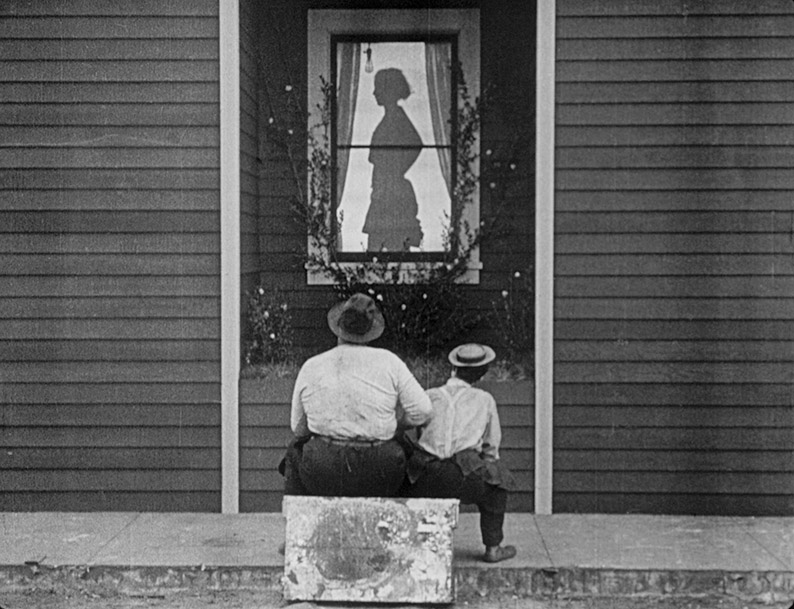
And yet here the entire film has been recovered, complete – we would hope – with the original intertitles. Even more dramatic is the inclusion of a pre-release version of The Blacksmith, which includes sequences that are not in the release print, though it does consequently exclude others that made it to the more commonly seen version, including a restored and slightly risqué one where Keaton is being chased by the Blacksmith of the title (played by Keaton regular Joe Roberts) and both put their conflict on pause to sit and watch a woman undressing in silhouette through the curtained window of her house. One sequence that didn't make it into the release version has a society woman act with disdain towards Keaton after mistaking him for an African-American because his face is covered in oil. Ah…
There are also new music scores for all of the films, and in a number of cases we are offered the choice between two separate and often quite different scores, some of which have been ported over from the earlier DVD release.
Before I get going here, it's worth noting that many of the films in this collection no longer exist in anything close to a pristine form, something that those who own the previous Eureka DVD set will be all too aware of. Lobster Films in France have worked tirelessly to locate the best available materials and have restored the films here on a frame-by-frame basis from the ageing negatives, prints and master positives of wildly varying quality. As the restoration featurette on Disc 1 clearly illustrates, this sometimes meant that single shots had to be reconstructed from multiple sources to replace missing frames, and does mean that the picture quality can change quite dramatically within a single film, sometimes on a shot-by-shot basis. But the improvement over any previous DVD release here is clearly visible even on the most damaged of films, particularly in the stability of the image within frame – there is none of the previous picture juddering here – and the clarity and level of the visible detail. There is still plenty of damage visible on many of the films, and when a shot or scene has suffered a hailstorm of scratches there's not a lot you can do to remove them without seriously compromising the quality of the picture beneath. But there is still a marked improvement on the DVDs here, and some of the more dramatic damage has been seriously minimised or even eliminated, the result, no doubt, of locating a print or negative in better condition than those previously available. What really and repeatedly knocked me out of my seat, however, is the sheer quality of the best material here – there are whole sequences where the sharpness of the detail, the gorgeously rendered grey scale and the cleanliness of the picture make it genuinely hard to believe that we're looking at film that was shot almost a century ago and stored in less than ideal conditions with no thought of future preservation in mind. It's here that the differences between the previous DVD edition are at their most dramatic. Most of the films are monochrome, but a small number are tinted in the traditional silent manner, and subtly so. Given the considerable restrictions still facing the restoration team, this is a superb job that fully justifies the Blu-ray upgrade, and then some.
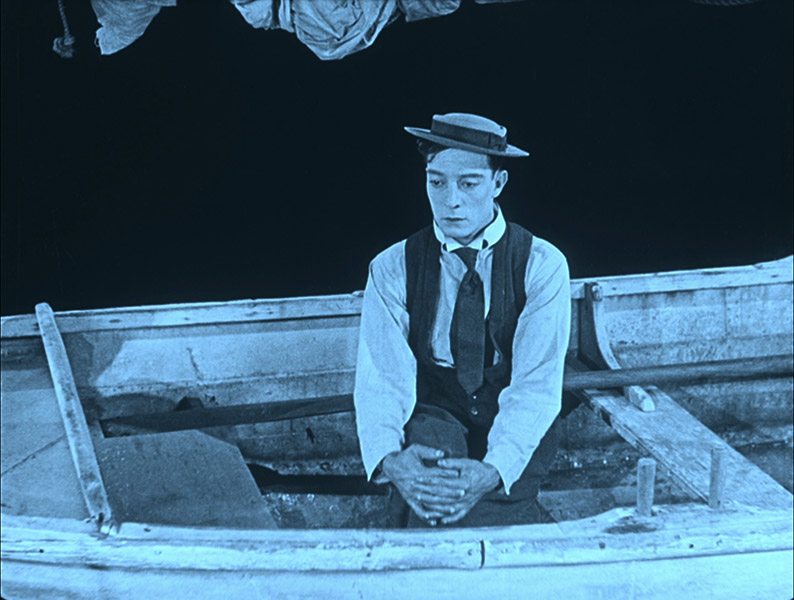
The music scores have all been encoded as Linear PCM stereo tracks and all sound terrific, with an excellent clarity and the sort of brightness and full-bodied range that showcases HD soundtracks at their best. A range of composers has contributed here, and as mentioned above you can sometimes choose between two different scores for a single film, which adds to this box set's sense of completeness. If I had to choose a favourite it would be Timothy Brock's lively and inventive score for Cops, but all the scores here most effectively compliment the visuals they are paired with. That said, I'm probably not the only one who got a bit of a jolt when Donald Sosin's orchestral score for Coney Island unexpectedly gives way to Joanna Seaton belting out the likes of Take Me Down to Coney Island and By the Beautiful Sea.
Disc 1
Coney Island Alternate Ending(0:45)
This was cut from the film in the 1920s and not included in the final restoration due to being what the opening caption warns is "racially offensive." They're not kidding.
The Restoration (6:44)
An enthusiastic Serge Bromberg from Lobster Films explores the challenges his team faced in restoring the films to their current condition. We don't get the sort of intricate detail or in-depth we've had from Friedrich Wilhelm Murnau Stiftung, but this is still essential and revealing viewing.
Disc 2
Commentaries by Joseph McBride on The 'High Sign', One Week and Convict 13
We are informed on the disc itself that these commentaries by film critic and historian Joseph McBride were recorded for the earlier DVD versions, and that due to the differences in length of the new restorations, it was impossible to correctly sync the commentaries to them, so the films here have been presented in their original form. This also gives you a chance to directly compare just how dramatic an improvement the new restorations sometimes are over their DVD predecessors. Unless you're already very well read on the films that McBride is discussing, all of the commentaries are informative and interesting, mixing analysis of scenes and intent with factual information about their filming and on Keaton and his collaborators. Some facts are repeated often enough to make you wonder if McBride is checking his notes (the same information about the Surrealist movement crops up on four of the six commentaries here), and just occasionally you wonder if he's reading more into a scene than is actually there, even on a subtextual level, but it's all worth hearing and worthy of debate.
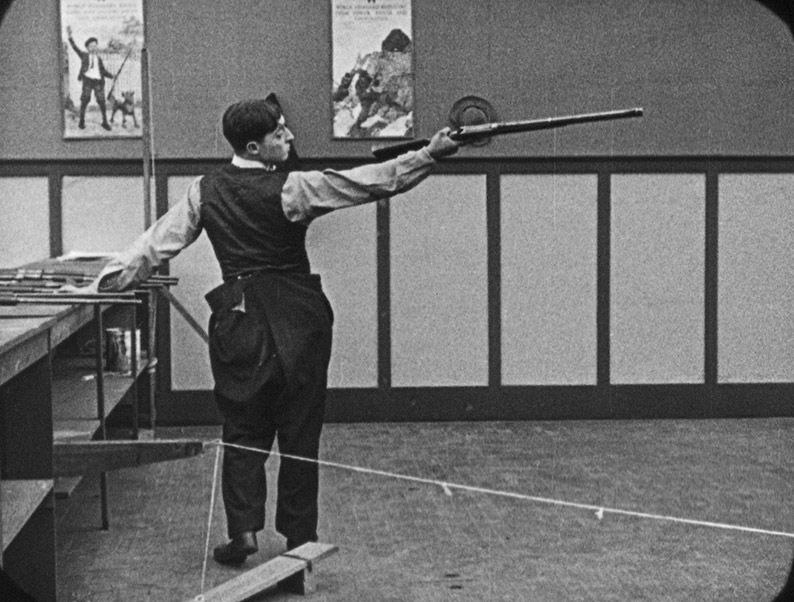
On his commentary for The 'High Sign' McBride usefully explains the origin of the title and talks about Keaton's love of mechanical gags, his directorial style, his vaudeville background and "the comedy of child abuse" (he does explain what he means by this and is not comfortable with it), the women in Keaton's films, and his frequent co-director (and actor) Eddie Cline. He nicely describes Keaton's screen persona as a child-like guy who gets into situations that he has to stoically cope with, and even quotes from books about and written by Keaton.
On the One Week commentary, MacBride notes that Keaton is not as sentimental about love and marriage as some other silent comedians, and that he treats female characters more like partners or pals than a certain Charlie Chaplin. Chaplin's name is repeatedly brought up by McBride as a negative to Keaton's positive, although the points he makes are usually backed up with considered argument. Keaton's regular technical director, Fred Gabourie, comes in for some well-deserved praise (it's he who had to build all of the mechanical contraptions and make them work) and he also covers Keaton's attitude to marriage and family life, the legends about Keaton being born in a tornado storm, and the concept of Keaton as an intellectual comedian, as well as paying tribute to the film's superb climactic stunt twist.
McBride reveals that Convict 13 was for many years a missing film, comments on the locations (he even recommends a book devoted exclusively to them) and talks about Keaton's unique way with spectacular falls, his lack of reaction shots and his gallows humour. The unfortunate and time-dated racial insensitivity in some of the films is tackled here, Chaplin is once again used for negative comparison (I refer you back to my opening paragraph) and the Surrealist movement gets its third introduction in just three commentaries.
That's Some Buster (22:39)
I've not always warmed to David Cairns' video essays for Eureka and Arrow, but this is a good one, riffing on the definitive writings of Walter Kerr in The Silent Clowns to explore a number of key traits of Keaton's comedy, and using clips from a range of his films to neatly and persuasively illustrate the points being made. At one point he describes Keaton rather nicely as the "Philip K. Dick of knockabout," notes the importance of silence in Keaton's comedy, and praises his gags as the most ingenious of any silent comedian. He also undermined one of my own observations above by noting that the dream sequence in The Playhouse anticipates the later one in Being John Malkovich.
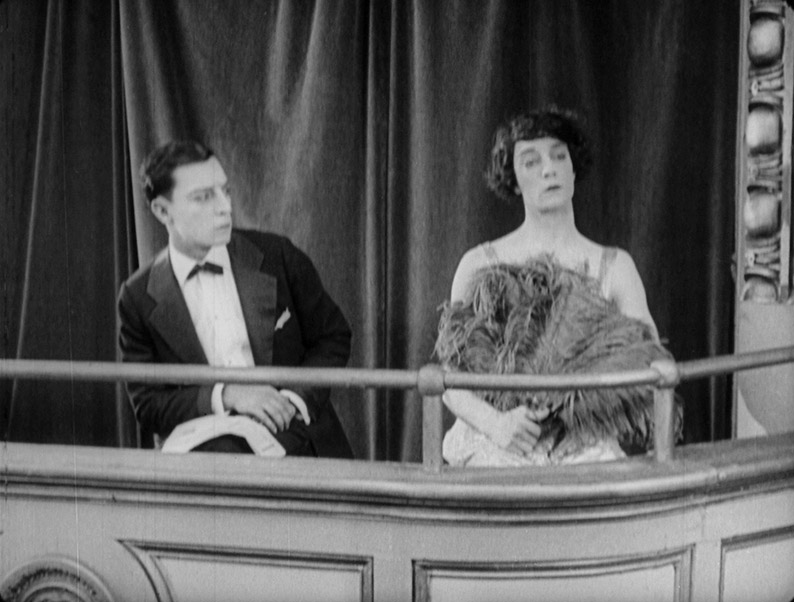
Life with Buster Keaton (2:50)
A short extract from a 35mm reshoot of a sequence from a 1950 Clyde Bruckman TV show in which Keaton regularly appeared, taken from a German print but with the German narration replaced with the original music. In it, Keaton plays a ludicrously dressed erotic dancer performing for a thoroughly bored emperor in a scene that has strong echoes of a similar sequence involving Keaton and Arbuckle in The Cook.
Disc 3
Joseph McBride commentary on The Playhouse
Describing the film up front as "a surreal tour-de-force," McBride provides some welcome information on how the seamless multiple exposures were achieved (and remember, this was all done in-camera), comments on the smartness of the post-dream misdirection, and reveals that Keaton's third wife described him as "a simple man." The inevitable dig at a certain other silent comedian comes with McBride's suggestion that Keaton wasn't as popular as Chaplin in part because audiences didn't know what to expect with him – frankly, he may be on to something there. There's plenty more, all good.
Joseph McBride commentary on The Boat
Nailing his flag to the mast by describing the film as one of Keaton's short masterpieces, McBride draws comparisons with One Week and finds connections with Keaton's own (abused?) childhood in his handling of the children here. Fred Gabourie come in for more praise for his work on the boats and the brilliant rotating interior set, and McBride makes some interesting comments on the darker elements of Keaton's work and his reasons for not smiling and playing it straight, though he loses me a bit when he finds Freudian reading in the funnel of a boat that I'm pretty sure would have a funnel by default.
Pierre Étaix (12:13)
French clown, comedian and filmmaker Pierre Étaix provides a fascinating commentary on a number of his favourite sequences from the films in this collection, noting the influence of Keaton's vaudeville background on his film comedy, the importance of having a regular team of collaborators, his use of composition for comic effect, and plenty more. He also notes that comedy has somehow lost its finesse. He may be right.
Disc 4
Joseph McBride commentary on Cops (18:13)
Describing this up front as "Keaton's greatest short," McBride notes that Keaton loved gags that dovetail into one another and celebrates the documentary aspect of the film, Keaton's stunt work, and how he was able to use camera and editing to substantially increase the number of policemen we see on screen. He provides some useful background detail on Red Scare America to clarify the role of an anarchist in the film, and also on the Arbuckle rape and murder trial and how Keaton's view of how it was (mis-) handled may be reflected in the film.
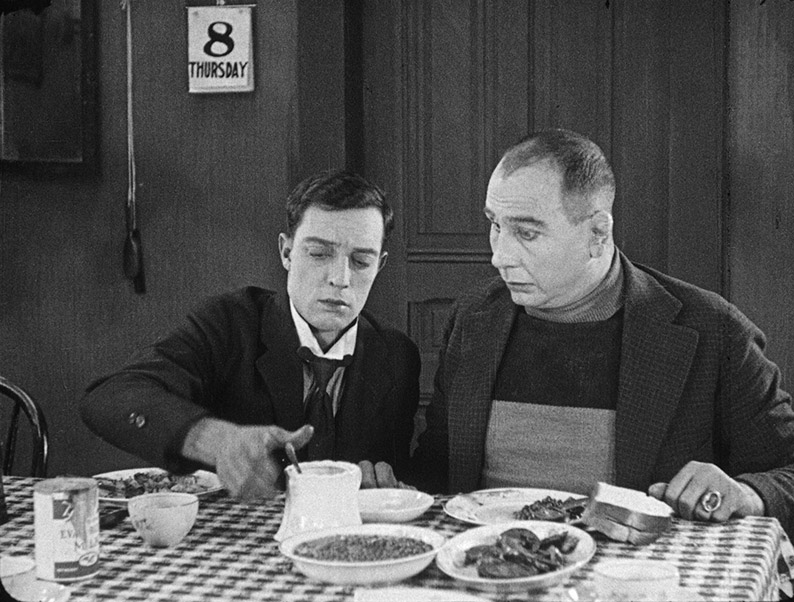
My Wife's Relations Alternative Ending (1:53)
An alternative (and very different) ending to My Wife's Relations, which is run side-by-side with the original with an encouragement for you to choose which one you like best.
Buster Keaton Party, 1962 (23:51)
Extracts from an audio recording of an informal party at home of US TV writer Bill Cox where Keaton sings and regales those present with his vaudeville memories. The singing tends to dominate, but Keaton is clearly having the time of his life here, and it proves oddly fascinating to only be able to hear the voice of someone who elsewhere in this set is stonily silent. Plasma TV owners beware, the same graphic and text stays up on screen for the entire running time.
Booklet
Booklet? Hardly. This is a fully-fledged, 184-page book that is packed with great material, one I'd happily pay good money for if it were a stand-alone release. Kicking off with the above quoted intro by Serge Bromberg and a list of all the films and their respective directors, the contents are: a splendidly detailed essay titled Buster Keaton's Short Comedies 1917-1923; notes and credits for each of the 32 films in this collection; a short but useful piece by Serge Bromberg titled The Two Versions of The Blacksmith and Other Discoveries; fascinating articles by Buster Keaton on his childhood, his friend and mentor Roscoe Arbuckle, and the process of making films; a lengthy, in-depth and compelling roundtable discussion on Keaton conducted in 2006 between Jean-Pierre Coursodon, Dan Sallitt, and Brad Stevens that covers so much ground that it effectively renders any reviews almost redundant; an extract from Keaton's autobiography titled From Human Mop to Stoneface; a surprisingly detailed piece on Keaton's Italian villa; a list of titles for suggested further reading; notes on the music and credits for the scores; restoration and Blu-ray credits; and a nice selection of stills, some of which are of Keaton behind the scenes or away from the film set.
Sublime. A selection of 32 of the finest of all silent comedies that chart the development of one of early American comedy cinema's most talented artists from supporting player to writer, director and star, all restored and presented in HD at the best quality you're likely to see them in, at least for a good many years to come. Great films, great scores and great entertainment, all backed by some pretty fine extra features and a 184-page book to die for. Very highly recommended.
|